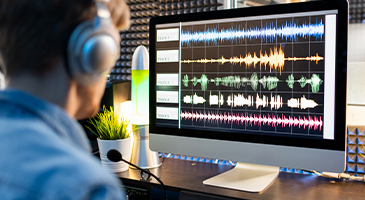Audio and video forensics has emerged as a crucial branch of forensic science in the modern digital era. With the rapid increase in multimedia technology, criminal activities, frauds, and disputes often involve audio or video recordings as evidence. These recordings may include phone calls, CCTV footage, social media videos, or even digital voice messages. However, the authenticity, reliability, and integrity of such evidence must be established before it can be presented in a court of law. For this purpose, forensic experts employ a wide range of tools and software specifically designed for the analysis, authentication, enhancement, and interpretation of audio and video files.
This note discusses the commonly used tools in audio and video forensic examination, highlighting their functions, applications, and importance in criminal investigations.
1. Audio Forensic Tools
Audio forensic tools are specialized software programs used to analyze, authenticate, and improve the quality of sound recordings. These tools help experts detect tampering, remove noise, and identify speakers.
a) Adobe Audition
Adobe Audition is a professional digital audio workstation widely used in forensic audio analysis. It allows experts to filter unwanted background sounds, enhance speech clarity, and analyze waveforms. The tool provides spectral frequency display, which helps detect splicing, edits, or unusual patterns in recordings.
b) Audacity
Audacity is a free, open-source audio editing tool used in basic forensic tasks. It supports multiple formats and provides noise reduction, trimming, and waveform visualization features. Though not as advanced as commercial tools, it is frequently used for preliminary analysis and educational purposes.
c) iZotope RX
iZotope RX is considered one of the most advanced forensic audio tools. It specializes in audio repair and restoration, making it useful for enhancing low-quality recordings. Its modules include noise reduction, spectral editing, and de-clipping, which help in clarifying distorted or damaged recordings.
d) GoldWave
GoldWave is an affordable and versatile audio editing software that forensic experts use for tasks such as filtering, conversion, and enhancement. It can process large files and offers features like noise reduction, pitch analysis, and spectrum display.
e) Forensic Audio Workstation (FAW)
FAW systems are specifically designed for law enforcement and forensic laboratories. They include a combination of advanced tools for authentication, editing detection, and speech enhancement. These workstations ensure compliance with legal standards for presenting audio evidence in court.
2. Video Forensic Tools
Video forensic tools help investigators analyze video evidence, detect manipulation, and enhance visibility. With the increasing use of CCTV cameras, smartphones, and digital surveillance systems, these tools have become essential for crime investigation and evidence validation.
a) Amped FIVE (Forensic Image and Video Enhancement)
Amped FIVE is one of the most recognized video forensic tools. It provides over 100 filters for video enhancement, such as deblurring, adjusting brightness, stabilizing shaky videos, and clarifying license plates or facial features. It also supports authentication, allowing experts to identify signs of tampering or editing.
b) Amped Authenticate
This tool is specifically designed for video and image authentication. It helps forensic experts verify whether a video has been altered, compressed, or manipulated. It examines metadata, file structures, and compression artifacts to detect inconsistencies.
c) Input-ACE
Input-ACE is a video investigation software used widely by law enforcement agencies. It can process proprietary CCTV file formats, create accurate video timelines, and enhance playback for court presentation. Its ability to work with multiple video sources makes it a powerful tool in criminal cases.
d) MotionDSP (Ikena Forensic)
MotionDSP provides real-time video enhancement and forensic analysis. It helps improve poor-quality surveillance footage by reducing noise, stabilizing shaky recordings, and clarifying details. Its frame-by-frame analysis feature is particularly useful in crime scene investigations.
e) ClearID
ClearID is a forensic plugin for Adobe Photoshop, focusing on still images extracted from video files. It allows for image clarification, sharpening, and enhancement, which can help identify suspects or objects captured in low-quality footage.
f) VideoFOCUS Pro
This tool allows forensic experts to capture, analyze, and enhance video evidence from multiple sources. It provides easy frame-by-frame analysis, still image extraction, and playback control, ensuring accurate interpretation of video recordings.
3. Importance of Audio and Video Forensic Tools
1. Authentication of Evidence – Tools help verify whether a recording is original or has been altered, which is vital for ensuring admissibility in court.
2. Enhancement of Quality – Poor recordings from surveillance cameras or mobile phones can be enhanced to reveal voices, faces, or license plates.
3. Detection of Tampering – Forensic tools can identify splicing, compression artifacts, or digital fingerprints that indicate manipulation.
4. Speaker and Voice Identification – Audio tools assist in speaker comparison and voice profiling, which can link suspects to a crime.
5. Presentation in Court – Many forensic tools generate reports and visuals that are understandable to judges and juries, strengthening the reliability of evidence.
4. Challenges and Limitations
While these tools are powerful, they also face challenges. Factors such as poor recording conditions, heavy background noise, and highly compressed files may limit the effectiveness of enhancement. Moreover, advanced editing technologies, like deepfakes, make it increasingly difficult to detect manipulations. Therefore, forensic experts must combine technical tools with professional expertise and follow strict forensic protocols to ensure accuracy and reliability.
Conclusion
Audio and video forensic tools play a vital role in modern criminal investigations. They provide the technical support needed to authenticate, analyze, and enhance digital evidence, ensuring that only reliable and accurate information is presented in court. From software like Adobe Audition and iZotope RX for audio analysis to advanced tools like Amped FIVE and Input-ACE for video examination, these technologies strengthen the justice system by uncovering the truth hidden in multimedia evidence. However, their use requires skilled forensic experts who can balance technology with scientific principles and legal standards. In an era where digital recordings are easily manipulated, these tools act as the backbone of forensic examinations, ensuring justice through science.

